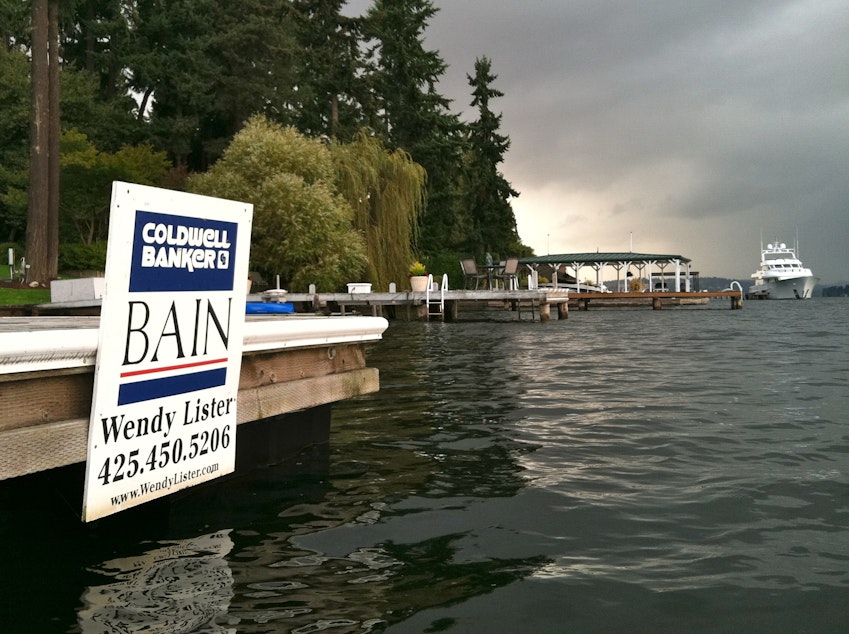Campaign Cash Maps Show Cracks In Washington's Cascade Curtain

You may have seen maps of the United States divided into red and blue, based on whether Republicans or Democrats got the most votes in each area. What would it look like to map how campaign contributors vote with their dollars?
The first map below does just that for Washington state. It follows the money to show how each ZIP code in the state has voted with its collective pocketbook in this year’s federal elections. Have people in that ZIP code contributed more money to Democratic (blue) or Republican (red) efforts?
Zoom in on the map for more detail. Click on any shaded ZIP code to see how much money was spent on this year's federal elections -- and how the money split between Democrats (and their committees, super PACs and other surrogates) and Republicans (and their various surrogates).
The political money follows the voting pattern long familiar to the state's political observers: mostly blue west of the Cascades; mostly red to the east. But exceptions abound, with the east side of Lake Washington, rural parts of Snohomish and Whatcom counties and much of southwest Washington leaning red. Much of north-central Washington and scattered pockets throughout eastern Washington lean blue.
Sponsored
According to the Center for Responsive Politics in Washington, D.C., 2012 is the most expensive election in the nation’s history. Here in Washington state, residents have poured more than $60 million into this year’s congressional and presidential elections. Overall, Washington state contributions toward federal campaigns have strongly favored Democrats and their surrogate organizations over Republicans and theirs ($33.7 million vs. $18.6 million).
A simple blue-versus-red map doesn’t show where the big money has come from. Last week KUOW mapped and zoomed in on the 10 Washington ZIP codes -- all fairly wealthy areas around Seattle -- that have spent at least $1 million to influence this year’s federal elections.
This next map shows only those ZIP codes that gave at least $50,000 in this year’s federal elections (again, zoom in or click on a shaded area for more details):
Some ZIP codes dropped out of this map because they have much smaller populations than others. It’s also apparent that some ZIP codes have a lot more cash available to throw at political campaigns: wealthy neighborhoods in Seattle and its eastern suburbs, for example. Here’s how the money maps out if we only include ZIP codes that gave at least $250,000:
Sponsored
Finally, the last map shows ZIP codes that have spent at least $500,000 on this year's federal elections. Note how the northern and eastern neighborhoods of greater Seattle dominate the state map, while south Seattle and south King County, typically more diverse and less wealthy than areas to their north, have fallen off the map. (Zoom out to see the two ZIP codes in Clark County that also gave more than $500,000.)
People can try to exercise or gain political power in any number of ways: voting, volunteering and spending money, to name a few. With rising inequality and fewer restrictions on in the influx of cash into our federal system of elections, it's gotten easier to use cash in pursuit of political power.
Even so, few people exercise that power.
Sponsored
Washington has 3.85 million registered voters, with some 3 million of them expected to cast votes in this election. That's about 40 times the number of Washingtonians who have made campaign contributions -- of any size -- this election cycle, according to Federal Elections Commission data. At least as far as federal campaign contributions go, it appears that political power in Washington state is concentrated in a small number of hands. And a very small number of ZIP codes.
Postscript
You may have noticed that some areas are unshaded in all the maps. Those areas either made no federal campaign contributions, made none that could be assigned to the two major parties or (in a few instances) were simply missing from the U.S. Census Bureau geographic data we used to generate these maps. All maps were produced by KUOW using Federal Elections Commission campaign-finance numbers as of Oct. 15, 2012.

